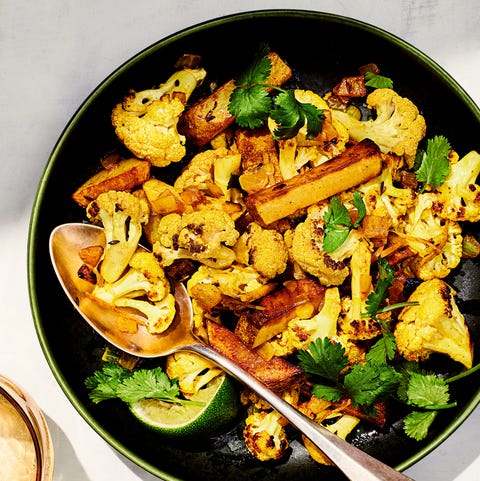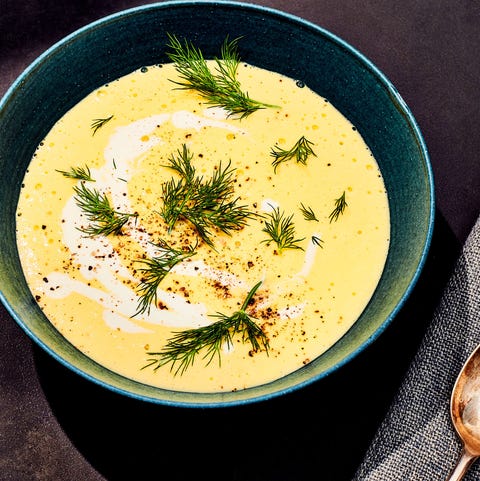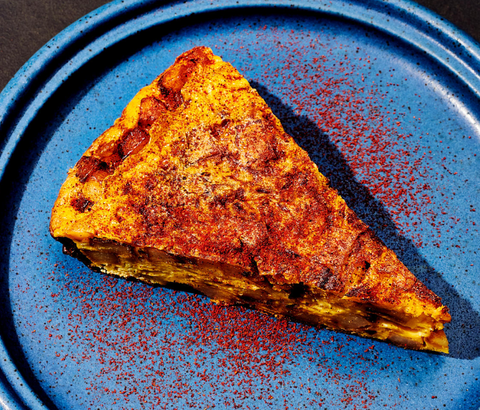Long Live the Potato, the Original Superfood
MISGUIDED DIETS and pseudo-experts have for years tried to slander the lowly potato as a fattening food and blood-sugar saboteur.
Ignore the lies.
Unload your guilt.
Real science stands behind the nutritional power of the potato—in all it’s delicious glory.
And if you want to pinpoint when the potato’s reputation went from healthful vegetable to nutritional pariah, go back to 1981 and two guys (okay, physicians) who invented something called the glycemic index.
Also known as the GI, this system assigned a numeric value to foods based upon the extent to which they affect your blood-sugar levels. If a food has a high GI value, that food may spike these levels. For people suffering from diabetes, the spikes and the crashes that follow can be dangerous. For the rest of us, high-GI foods play yo-yo with our blood sugar and may even lead to diabetes.

So it goes that high-glycemic foods should be avoided: cornflakes, rice cakes, and . . . wait for it . . . white potatoes. In fact, a baked russet potato carries one of the highest glycemic loads of all—greater than a Snickers bar, Coca-Cola, and even processed white bread.
Then in 2011, a New England Journal of Medicine study made things even worse by launching this broadside: “Potato products (which are low in sugars and high in starches) showed the strongest associations with weight gain.”
And so potatoes, now dubbed a high-GI, high-starch food by the scientific community, became an easy target for low-carb keto and paleo zealots looking to cut carbs for weight loss. Boiled, baked, hashed, smashed, and especially french fried—potatoes, the slanderers charged, will turn your six-pack into one giant tot.
Except that nutritional science wasn’t settled at all, and it doesn’t take into account recent discoveries or common-sense considerations. One medium-sized baked potato delivers six grams of protein and four grams of fiber, as well as high amounts of bone-assisting calcium, heart-helping potassium, and immunity-supporting vitamin C—all for just 265 calories.
Potatoes are affordable and available everywhere, last for months if stored properly, and—as anyone who has ever enjoyed a scoop of well-whipped mashed potatoes or al dente gnocchi knows—are incredibly delicious and satisfying.
As for the glycemic index, experts say that it’s been misused and hasn’t always been applied appropriately. “We tend to eat potatoes as part of a mixed meal. So we might actually eat a potato with more fiber and fat, which decreases that spike in your blood sugar,” says Danielle Meyer, R.D., the clinical director of the Dietetic Internship at the University at Buffalo.

What’s more, in 2018, when British scientists looked at the totality of the research on potatoes, obesity, type 2 diabetes, and heart disease, they found that too many studies contradicted one another and lacked detail on cooking methods.
Plus, many of the reports did not account for satiety, the term dietitians use to describe staying full after a meal. “The humble potato can be a filling, nutrient-providing component to your meal,” says Mindy Haar, Ph.D., R.D.N., a fellow of the Academy of Nutrition and Dietetics.
As far as starch goes, potatoes contain a powerful kind—resistant starch—that your body cannot break down quickly into glucose as it does with, say, the starch in white bread.
Resistant starch passes through the small intestine undigested and ferments in the large intestine, feeding the good bacteria in your gut. It functions like soluble fiber, helping you eat less over the course of the day.
Which is one more reason to enjoy potatoes. The rib-sticking, nutrient-loaded recipes that follow will show you the (many) tasty ways to do just that.
Roasted Aloo Gobhi
This recipe for aloo gobhi, a potato and cauliflower curry, is adapted from Indian-ish, coauthored by Priya Krishna.

“By roasting the potatoes before sauteing them, you ensure they stay crisp and intact rather than turning into mush—mush is the enemy of aloo gobhi!” Krishna says.
What You’ll Need:
• 2 medium russet potatoes, cut into 2-inch-long sticks
• 1 medium head cauliflower, cut into small florets
• 3 Tbsp olive oil, plus 2 Tbsp
• 1 tsp cumin seeds
• 1/2 tsp ground turmeric
• 1 small yellow onion, finely diced
• 1 pinch cayenne
• 1 Tbsp julienned fresh ginger
• 1 Tbsp fresh lime juice
• 1/2 cup chopped fresh cilantro
How to Make It:
1. Preheat the oven to 400°F. Line a baking sheet with foil, add the potatoes and cauliflower, toss with 3 Tbsp olive oil, spread in an even layer, and roast until the vegetables are browned and slightly crisped, about 30 minutes, tossing halfway through. Remove and set aside.
2. In a large pan over medium high, heat the rest of the oil. Add the cumin and cook till aromatic, 30 to 60 seconds. Reduce the heat to medium and stir in the turmeric and onion. Saute until the onion softens, 4 to 6 minutes. Add the cayenne and ginger. Cook 1 minute.
3. Add the potatoes and cauliflower, along with any charred bits from the foil. Gently mix, add 1 tsp Kosher salt, and cook, stirring occasionally, until the vegetables are tender, 5 to 6 minutes. Remove from the heat, add the lime juice, and season to taste. Garnish with cilantro. Feeds 4
The Ultimate Sweet Potato
Sweet potatoes are actually from a totally different plant family (morning glory, if you’re curious) from other potato varieties.

Though they’re slightly lower in calories and carbs, and marginally higher in fiber, there’s nothing that makes them nutritionally superior to traditional potatoes. However, that sweet flavor and moist texture make them perfect for baking, like in the recipe below from David Nayfeld, executive chef and co-owner of Che Fico in San Francisco. “Whatever you do,” he says, “don’t skimp on the butter.”
What You’ll Need:
• 1 medium to large sweet potato
• 1/2 lemon
• 2 Tbsp grass-fed butter
• Coarse sea salt
How to Make It:
Preheat the oven to 450°F. Place the sweet potato on a baking sheet and roast until it begins to expel a caramel-colored liquid and the skin crisps, 45 to 60 minutes. Carefully remove from the oven, slice in half, squeeze the lemon’s juice over both halves, slather with butter, and season with salt. Feeds 1
Corn and Potato Soup
This recipe adapted from Chasing Flavor, by Dan Kluger, chef/owner of Loring Place restaurant in N. Y. C.

“It’s one of those rare soups that is just as good warm as it is cold,” says Kluger. Credit the potatoes, which take on a silky texture when chilled.
What You’ll Need:
• 2 Tbsp extra-virgin olive oil
• 1 cup finely chopped white onion (about ½ medium onion)
• 4 garlic cloves, thinly sliced
• 3 cup corn kernels, fresh or frozen
• 1 Yukon gold potato, roughly chopped
• 4 cups chicken stock
How to Make It:
1. In a medium saucepan, heat the olive oil over medium -low. Add the onion, garlic, and a pinch of salt and cook, stirring occasionally, until translucent, about 5 minutes.
2. Add the corn kernels, potatoes, and corn stock. Bring the liquid to a boil over high, and then lower the heat to medium and simmer until the potatoes are tender, 15 to 20 minutes.
3. Allow the mixture to cool slightly and then transfer to a blender, working in batches as to not overfill the blender, and puree until very smooth. Season with salt and pepper to taste. Serve immediately or chill. Serve with a swirl of heavy cream and dill. Feeds 4
Tortilla de Patatas
This recipe comes from Ramón Martinez, culinary director of Jaleo restaurants.

The flipping of the Spanish egg-and-potato tortilla is key. Lean on your fortitude. Do not hesitate. Flip with resolve.
What You’ll Need:
• 2 cups thinly sliced sweet onion, thinly sliced
• 2 cups, plus 2 Tbsp extra-virgin olive oil, ideally Spanish, plus 2 Tbsp
• 3 russet potatoes, peeled and diced into ½-inch cubes
• 6 large eggs
• Smoked paprika
How to Make It:
1. In a medium pot over medium-high, heat the 2 cups olive oil until it reaches 300°F. Add the onions and cook till they begin to brown at the edges, 8 to 10 minutes. Add the potatoes and cook till golden brown, about 20 minutes. Drain the mixture and season to taste. (You can reserve the olive oil for future tortillas.)
2. In a large bowl, using an electric mixer, beat the eggs with 2 tsp salt. Mix the potatoes into the eggs.
3. In a medium pan over high, heat the remaining 2 Tbsp olive oil. When the pan begins to smoke slightly, remove from the heat, pour in the potato mixture, return it to the stove, and heat over medium-low. Cook until the edges start turning golden brown, 8 to 10 minutes.
4. Work a rubber spatula around the sides of the tortilla and underneath to lift it from the surface of the pan. Place a large plate over the tortilla. Cover your arm with a dish towel for protection and, over a sink (just in case), swiftly and surely flip the pan and plate together so the tortilla ends up on the plate, uncooked side down. Slide the tortilla back into the pan, uncooked side down. Once the tortilla sets, about 1 minute, flip the tortilla back over and transfer to a platter. Cut into wedges to serve dusted with smoked paprika. Feeds 4
A version of this article originally appeared in the May 2021 issue of Men’s Health.
Source: Read Full Article
